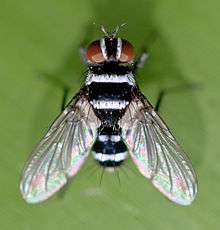Trigonospila
Trigonospila is a small genus of parasitic flies in the family Tachinidae.[2][3] Known hosts of Trigonospila are Lepidoptera.[3]
| Trigonospila | |
|---|---|
 | |
| Scientific classification | |
| Kingdom: | |
| Phylum: | |
| Class: | |
| Order: | |
| Family: | |
| Subfamily: | |
| Tribe: | |
| Genus: | Trigonospila Pokorny, 1886 |
| Type species | |
| Trigonospila picta Pokorny, 1886 | |
| Synonyms [1] | |
Distribution
The genus has a worldwide distribution, but is particularly common in Australia. In Australia, T. brevifacies and T. cingulata are common within their respective ranges and can often be found resting on vegetation. They have been reported in some environments to be the most common conspicuous fly species.[4] In Australia, Trigonospila have been collected in all mainland states and territories, Tasmania, and some large offshore islands including Kangaroo Island in South Australia, and Brampton Island in Queensland.
Identification
Trigonospila are strikingly patterned flies; primarily black with pearly whitish to golden transverse bars on the thorax and abdomen. There are two whitish bars on the thorax; one adjacent to the transverse suture, and the second adjacent to the scutellum. There may also be a white triangle on the tip of the scutellum, and the subscutellum is usually white. Abdominal colouration varies between species however it is typical that there are three whitish bars on the abdomen; one at the anterior margin of each the third, fourth, and fifth abdominal tergites. The width of these bars differs between species.[4]
Biocontrol applications
T. brevifacies is a polyphagous parasitoid of the larvae of Lepidoptera and is native to the eastern states of Australia with a range extending from Tasmania to southern Queensland and possibly as far west as South Australia. T. brevifacies has been deployed in New Zealand as a biocontrol agent of a number of agricultural pests including the light brown apple moth Epiphyas postvittana (Lepidoptera : Tortricidae) and the potato tuber moth Phthorimaea operculella (Lepidoptera : Gelechiidae).[3]
T. cingulata and T. fasciata are believed to be parasitoids of chrysomelid beetles in the genus Paropsis,[3] some of which may be pests of agriculture or forestry.
Species
- T. bimaculata (Villeneuve, 1935)
- T. braueri (Townsend, 1933)
- T. brevifacies (Hardy, 1934)[4]
- T. cingulata (Macquart, 1851)
- T. erilis (Reinhard, 1943)
- T. fasciata (Hardy, 1934)[4]
- T. integra (Villeneuve, 1935)
- T. ludio (Zetterstedt, 1849)
- T. transvittata (Pandellé, 1896)
References
- James E. O'Hara (December 31, 2008). "World Genera of the Tachinidae (Diptera) and their Regional Occurrence" (PDF). Version 4.0. University of Guelph. Retrieved August 1, 2010.
- James E. O'Hara, Hiroshi Shima, & Chuntian Zhang. "Annotated Catalogue of the Tachinidae (Insecta: Diptera) of China." Zootaxa 2190 (2009): 1-236.
- Crosskey RW (1973) A conspectus of the Tachinidae (Diptera) of Australia, including keys to the supraspecific taxa and taxonomic and host catalogues. Bulletin of the British Museum (Natural History) Supp. 21, London.
- Hardy, G.M. (1934). "Notes on Australian Muscoidea (Calyptrata)". Proceedings of the Royal Society of Queensland. The Royal Society of Queensland. 45: 30–37.